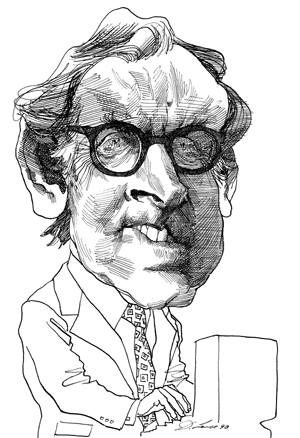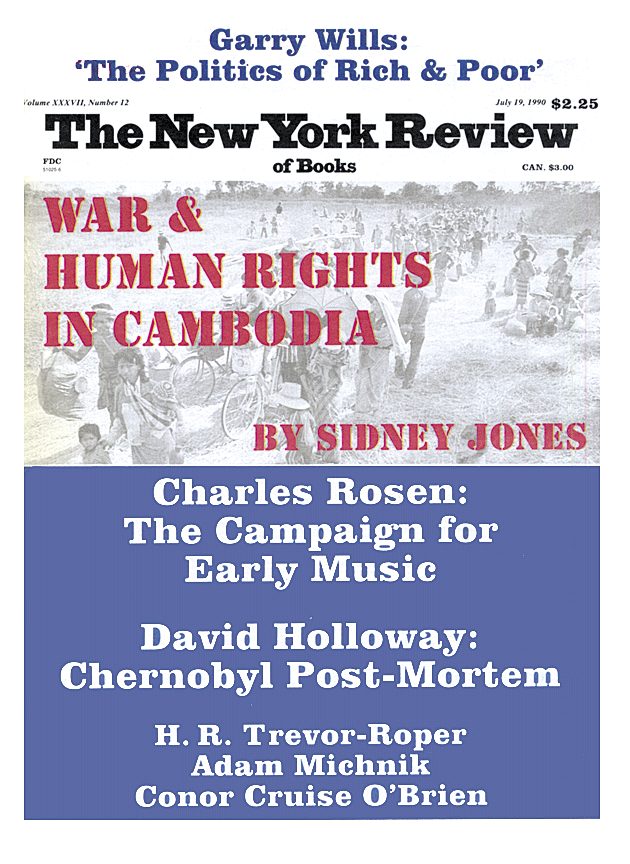“Politics, as a practice, whatever its professions, had always been the systematic organization of hatreds.”1 Henry Adams derived that earthy insight from a favorite author, Blaise Pascal. In his copy of the Pensées, now at the Massachusetts Historical Society, Adams marked this passage: “Tous les hommes se haissent naturellement l’un l’autre.”2 Pascal goes on in the same fragment to describe zeal for the common good as a pretense.
I first heard this doctrine from a less lofty oracle. Early in the 1968 presidential campaign, an aide to John Mitchell told me “the whole secret of politics—knowing who hates who.” The young Kevin Phillips was widely credited with Nixon’s “southern strategy” in that year; but he had many strategies, for different parts of the country. I was impressed by Phillips, and devoted six pages of the book I was working on to the predictions he made well before the 1968 election:
Sure, Hubert will carry Riverside Drive in November, La-de-dah. What will he do in Oklahoma?…Wallace is helping, too—in the long run…. We’ll get two thirds to three fourths of the Wallace vote in 1972…. I’d hate to be the opponent in that race. Teddy better wait twelve or sixteen years…. When Hubie loses, [Eugene] McCarthy and [Al] Lowenstein backers are going to take the party so far to the Left they’ll just become irrelevant. They’ll do to it what our economic royalists did to us in 1936.3
Phillips was the perfect man for Nixon. He is a connoisseur of grievances, and profoundly uninterested in ideology: “This is not a movement in favor of laissez-faire or any ideology; it is opposed to welfare and the Establishment.”4 When I asked him what a Nixon government would be like, he answered in the categories he understands: “Irish and Jewish, just like Nixon’s law firm.”5
Now Phillips has written a book about Reagan’s government. What was it like? “Beverly Hills and Wall Street” is the answer he gives, with the familiar growl. He is at pains to dissociate Reagan’s party from the one he helped steer to victory in 1968. Nixon had a grudge against the rich (why should they escape his multitiered animosities?), and that is the kind of grudge that endears a man to Phillips: “His empathy with insecure, postwar middle-class America had stood out in his famous Checkers speech of 1952, which blended wariness of the rich with reference to his wife Pat’s ‘good Republican cloth coat.’ ” Phillips’s real contribution to the Republicans was not the southern strategy, based on racial hatred, but the incorporation of that into a broader form of right-wing populism. At the end of the last century, Populists united a muckraking press and regulating political reforms in an attack on economic privilege. But the original allies of populism had become part of the Establishment by 1968. The old muckrakers had been transformed into The Media. Regulators were The Bureaucracy. Businessmen could present themselves as mistreated by these powerful institutions, and Main Street would go along with them.
Reagan seemed typecast as the ordinary fellow defying Big Government and the smarty-pants New Class of elite communicators. But he brought in a new elite of glitterati whom Phillips denounces, here, as betrayers of rightwing populism. The party has given itself back to those “economic royalists” Phillips denounced in 1968. He is admirably consistent.
No one else has assembled a more scathing assault on the 1980s as a time of economic exploitation. Charts tracing income redistribution are enlivened by the Phillips venom. He personalizes his attack, going after the population explosion of billionaires. Matthew Josephson called the millionaire a vile invention of the Gilded Age. Phillips calls the billionaire-as-type no less a product of the Reagan era. We entered the Eighties with few if any of the creatures and had fifty-one of them by 1988. We had few decamillionaires or centimillionaires, either, as the decade began. We ended up with a million of the former and 1,200 of the latter. This was part of a general ballooning of income in what Phillips calls Upper America, where income tripled while it was being pinched off, in a graduated scale, for those lower and lower down.6
Nor was this simply a matter of money-hydraulics, cash being sluiced from broader but shallower channels into deepening wells. The wells were not being tapped for use. They did not obey what Phillips calls the “theology” of George Gilder, proclaimed as Reagan entered office, which called wealth a blessing even to those who do not hold it. Wealth, on the contrary, became staggeringly non-productive in the Reagan era. It was diverted into shelters. It was shuffled through paper deals; it financed its own disappearance; it erased others’ holdings, along with the banks that contained them. It depleted rather than replenished. It shriveled where it was supposed to irrigate.
Advertisement
Huge sums were bandied about at art auctions while bridges were disintegrating. Money flew in all directions at home, while seeping almost invisibly abroad. Lawyers, playing traffic cops to the cash flow, diverted so much of it to themselves that 1,318 partners of major firms averaged higher pay than the 800 top CEOs in the country. In the major law firms, among partners over forty years old, more than half were millionaires. As Phillips notes, lawyers have always been the targets of populist anger with nonproductive attendants on transactions.
Supply-side economics was supposed to promote savings, investment, and entrepreneurial creativity. It failed at all three. Ingenuity was not spent on building a better mousetrap but on inventing goldener parachutes, wilder buy-outs, trickier S&L investments. By the end of the Reagan term “a record 47 percent of all patents issued in the United States went to foreigners, compared with just 19 percent a quarter century earlier.” America became a debtor nation while private wealth grew, thanks to the interrelated Reagan policies of tax cuts, deficit, deregulation, and tight money.
Phillips prescribes a politics of grievance for Democrats to undo what his own “New Republican Majority” inflicted on the country. He castigates Dukakis for not picking up Jesse Jackson’s brand of populism in the last campaign, endorsing Governor Cuomo’s view that Jackson had “the single most identifiable and attractive message” among Democrats. Though Jackson himself was “limited by both race and Third World rhetoric,” Phillips thinks a white Democrat could make his themes work, could steal Jackson’s thunder in 1992 as Nixon stole Wallace’s in 1968. Even against the Massachusetts governor’s inept leadership, the Republicans lost three Pacific states (and barely won California), along with nearly fifty mid-west counties that had not voted Democratic since 1964. Bush’s 53 percent “was the weakest Republican presidential victory in a two-way race since 1908,” and “a switch of 535,000 votes in eleven states…could have elected even Dukakis.”
Phillips argues for an electoral shift by comparing the 1980s’ “blowout capitalism” with similar periods of excess—the Gilded Age and the Roaring Twenties. The first period led to the reaction of the Populists and the second to the New Deal. There are a number of fascinating parallels, cleverly developed by Phillips. He thinks, for instance, that the Social Darwinism of the 1880s is like George Gilder’s cult of business heroes in the 1980s.
But some of his comparisons work as contrasts. In charts of parallel events he aligns the market crash of 1987 with the panic of 1893 and the Crash of 1929. But the crash of 1987 was, by comparison with the other two, a tree failing noiselessly. People could go on as if it had not occurred at all. Certainly the populist angers Phillips wants to summon have been elusive so far. The enormities he describes have provoked surprisingly little public outrage. Perhaps only economic collapse on the scale of 1929 could accomplish that.
One reason for this detachment of the public from economic reality comes from the very changes in productivity Phillips is attacking. It is harder to understand dysfunction in a service economy than in the farm economy of the 1890s or the manufacturing economy of the 1920s.
If a capitalist is taking too much out of a car-manufacturing process, it is easy to empathize with those working on the assembly line: the public has no affective bond to the owner (or to, say, his engineers). But if people are taking huge sums out of VCR productions, that is because the payment of owners, lawyers, agents, distributors, and others is keyed to the high sums earned by top performers on the video cassettes, whom the public idolizes. Madonna’s lawyers are “service millionaires” of the sort Phillips wants people to get angry at. But they move dimly in her aureole. Even lacocca was perceived less as an owner or executive than as a celebrity salesman-performer, better known for his work on television than at a factory’s design board.
Phillips, moreover, has his prior accomplishments blocking his way. Who is going to make the case against the new economic royalists? The carriers of the bad news are those very “Big Media” Phillips worked to discredit in his Nixon-Agnew days (and in his 1975 book, Mediacracy). Reregulating the malefactors of great wealth would involve use of governmental instruments he subjected to ridicule. A Democratic resurgence is hard to imagine after the reduction of the parties’ ideological content that Nixon (not to mention Wallace) stood for.
Phillips has shown signs of mellowing over the years. He called for the healing of national divisions in Post-Conservative America (1982) and for a bipartisan industrial policy in Staying On Top (1984). Now, baffled by his lack of success in that gentler mode, he has returned to Ercle’s vein, preaching a new politics of grievance, this time on the Democrats’ side. It would be ironic if the master of knowing who should hate whom finds hatred lacking when we need it most. A nation that cannot get angry at its official betrayers has lost a resource more important than any trade advantage. Without intending it, Phillips may just have described in this new book his citizens’ limitless hornswogglability. On the other hand, strange things are still possible in a world that sees Kevin Phillips advancing Jesse Jackson’s program.
Advertisement
This Issue
July 19, 1990
-
1
Ernest Samuels ed., The Education of Henry Adams (Houghton Mifflin, 1974), p. 7. ↩
-
2
The sentence, on page 207 of Adams’s undated Garnier edition, is Fragment 210 in Louis Lafuma’s edition of the Pensées (Editions du Luxembourg, 1951), p. 147. ↩
-
3
Garry Wills, Nixon Agonistes (Houghton Mifflin, 1970), pp. 265–269. ↩
-
4
Garry Wills, Nixon Agonistes, p. 266. ↩
-
5
Garry Wills, Nixon Agonistes, p. 269. ↩
-
6
David Brock of the Heritage Foundation, attacking Phillips in The Wall Street Journal (June 14, 1990), argues that the poor did well under Reagan. To fabricate this claim, he starts from the trough of the Reagan recession in 1982. Beginning, as one ought, from a base in the Carter years, one finds that the lowest quintile of the population lost 5.1 percent of its income from 1979 to 1988. See table at page 1072 of the US House Committee on Ways and Means Green Book, 1990. ↩



